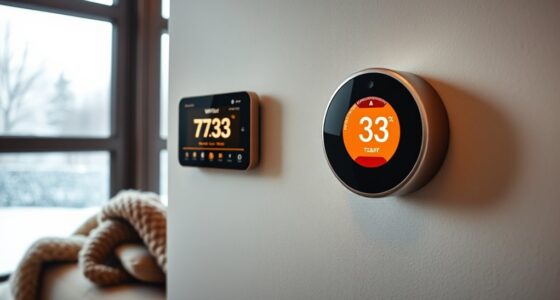Using adaptive thermostat schedules helps you save energy by automatically adjusting your home’s temperature based on your routines and preferences. These smart systems learn from your daily habits, ensuring your home is warm or cool only when needed. They also change settings when you’re away or asleep, preventing unnecessary energy use. This automation keeps your space comfortable while lowering utility bills. Keep exploring, and you’ll discover ways to optimize your home climate even further.
Key Takeaways
- Adaptive thermostats automatically adjust temperature settings based on daily routines, reducing energy waste when residents are away or asleep.
- Customizable schedules allow personalized control, optimizing comfort while minimizing unnecessary heating or cooling.
- Scheduling modes like “away” or “sleep” automatically modify temperatures, preventing manual adjustments and promoting energy savings.
- Learning algorithms analyze habits to refine schedules, ensuring efficient temperature regulation and proactive comfort management.
- Seamless integration with home decor and automation features enhances overall energy efficiency without sacrificing aesthetic appeal.

Adaptive thermostat schedules automatically adjust your home’s temperature settings based on your daily routines and preferences, helping you save energy and stay comfortable. By learning your habits, these smart systems optimize heating and cooling, ensuring you’re not wasting energy when you’re away or asleep. This tailored approach means you can reduce unnecessary energy consumption without sacrificing comfort, leading to noticeable savings on your utility bills.
One of the key benefits of adaptive schedules is the level of user customization they offer. You can set specific temperature preferences for different times of day or days of the week, giving you control over your home’s climate. Whether you prefer a warmer environment during the evenings or cooler temperatures during work hours, the thermostat adapts to suit your lifestyle. This personalized setup ensures your home remains comfortable while avoiding energy waste during periods when you don’t need heating or cooling.
Adaptive thermostats let you customize temperature settings for different times and days, maximizing comfort and energy efficiency.
The scheduling features often include the ability to create different modes, such as “away,” “sleep,” or “vacation,” allowing you to fine-tune your energy savings. When you’re not home, the thermostat can automatically lower or raise the temperature, minimizing energy use without your intervention. In the morning or evening, it adjusts to your preferred comfort levels, eliminating the need for manual adjustments and reducing the chances of forgetting to activate energy-saving settings. This automation not only simplifies your day-to-day life but also guarantees consistent energy efficiency.
Furthermore, adaptive thermostats often incorporate learning algorithms that refine their schedules over time. As they gather data on your routines, they become more precise in predicting your needs, further enhancing energy savings. For instance, if you typically come home from work at 6 p.m., the system will start warming or cooling your house just before that time, ensuring comfort without wasting energy all day. Additionally, many of these systems are compatible with Farmhouse Furniture styles, allowing for seamless integration into your home decor while maintaining energy efficiency. This continuous learning process means your thermostat gets smarter and more efficient, providing you with ongoing savings and comfort.
Frequently Asked Questions
Can Adaptive Schedules Be Used With Existing Smart Thermostats?
Yes, you can use adaptive schedules with existing smart thermostats. Most devices offer smart thermostat compatibility and allow schedule customization options, making it easy to set and adjust adaptive routines. You simply need to verify your thermostat supports these features, and then you can personalize your schedule for energy savings and comfort. Check your device’s specifications to confirm it offers adaptive scheduling, and you’re all set to optimize your home’s energy use.
How Do Adaptive Schedules Impact Energy Bills Long-Term?
Adaptive schedules can markedly reduce your energy bills over time by optimizing your thermostat settings based on your habits and preferences. As a result, you’ll enjoy consistent energy savings and lower costs, especially during peak seasons. By adjusting your thermostat intelligently, you minimize unnecessary heating and cooling, leading to effective cost reduction and long-term savings. This smart approach makes your home more energy-efficient and budget-friendly.
What Are the Privacy Concerns With Adaptive Thermostat Data?
You might worry about privacy breaches with adaptive thermostat data, as it tracks your daily routines. This data could be vulnerable if not properly secured, risking unauthorized access. Make sure your thermostat’s data security measures are robust, and review privacy settings regularly. Being aware of how your information is stored and shared helps protect your privacy and reduces concerns about potential breaches.
Are Adaptive Schedules Suitable for All Climate Zones?
Adaptive schedules work well across various climate differences, but their zone adaptability varies. In moderate climates, you’ll find them highly effective, adjusting temperatures based on your habits. However, in extreme zones with significant temperature fluctuations, you might need to manually fine-tune settings for ideal comfort. Always check if your thermostat supports zone adaptability features specific to your climate, ensuring the system works efficiently year-round.
How Does User Manual Override Affect Adaptive Schedule Efficiency?
Sure, manual override seems like a rebel move, but it actually hampers your schedule efficiency. When you manually adjust your thermostat, it’s like hitting pause on your energy-saving plan. The adaptive schedule can’t learn your patterns, wasting energy and money. So, if you want maximum savings, resist the urge to override. Let your smart thermostat do its job, and watch your energy bills drop—ironic, isn’t it?
Conclusion
By embracing adaptive thermostat schedules, you become the maestro of your home’s comfort symphony, guiding temperatures seamlessly through the day. Like a skilled gardener tending to delicate blooms, you nurture energy savings while ensuring coziness. This intelligent approach transforms your space into a living, breathing entity that responds effortlessly to your rhythms. Ultimately, you craft a sanctuary where comfort and conservation dance in perfect harmony, turning everyday energy use into a masterpiece of mindful living.









